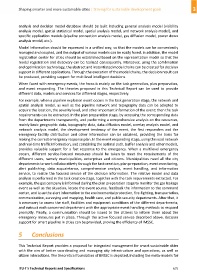Page 685 - Shaping smarter and more sustainable cities - Striving for sustainable development goals
P. 685
analysis and decision model database should be built including general analysis model (visibility
analysis model, spatial statistical model, spatial analysis model, and network analysis model), and
specific application models (pipeline connection analysis model, gas diffusion model, power down
analysis model, etc.).
Model information should be expressed in a unified way, so that the models can be conveniently
managed and coupled, and the output of various models can be easily fused. In addition, the model
registration center for cities should be established based on the representation model so that the
model registration and discovery can be realized consequently. Moreover, using the combination
and optimization technology, the abstract and instantiated model chains can be created for decision
support in different applications. Through the execution of the model chains, the decision result can
be produced, providing support for multilevel intelligent decisions.
When faced with emergency events, the focus is mainly on the task generation, plan preparation,
and event responding. The theories proposed in this Technical Report can be used to provide
different data, models and services for different stages, respectively.
For example, when a pipeline explosion event occurs in the task generation stage, the network and
spatial analysis model, as well as the pipeline network and topography data can be adopted to
acquire the location, the severity level, and other important information of the event; then the task
requirements can be extracted. In the plan preparation stage, by accessing the corresponding data
from the departments transparently, and performing a comprehensive analysis on the resources,
mainly basic geographic data, topography data, data diffusion model, overlay analysis model, and
network analysis model, the development tendency of the event, the first responders and the
emergency facility distribution and other information can be obtained, providing the basis for
making the correct emergency response plan. In the event responding stage, using the road network
and real‐time traffic information, and combining the optimal path, buffer analysis and other models,
provides valuable support for a fast response to the emergency. When a multilevel emergency
occurs, different service‐focused measures should be taken to meet the requirements of the
different users, namely municipalities, enterprises and citizens. Municipalities need all the city
departments to work collaboratively through the task creation, plan preparation, event monitoring,
alert publishing, data acquaintance, comprehensive analysis, event handling, and information
service, to realize the focused service of the decision information. The relative model and data
analysis is performed in the task creation stage, together with the task requirements extracted. For
example, the gas company is informed during the plan preparation stage to monitor the gas leakage
event as well as the situation, locate the event source, feedback the information to the command
center, and issue the alert information to the environmental protection, fire‐fighting, transportation,
communication, surveying and mapping, health care, and public security departments. After that, it
is necessary to assess the staff, facilities and equipment conditions of the different departments,
and instruct each concerned department with the appropriate event handling methods to respond
promptly. Finally, a communication should be issued to the citizens to inform them about the
emergency measures put in place. Through the active focused service described above, decision
support for smart pipeline in cities can be provided, proving the efficiency of IMSSC.
5 Conclusions
This Technical Report provides a proposal for integrated management for smart sustainable cities
with the aim of better coordinating and managing city infrastructure and operations, as well as
citizen interactions. The theoretical foundation of IMSSC is depicted, including the meta‐models for
ITU‐T's Technical Reports and Specifications 675

